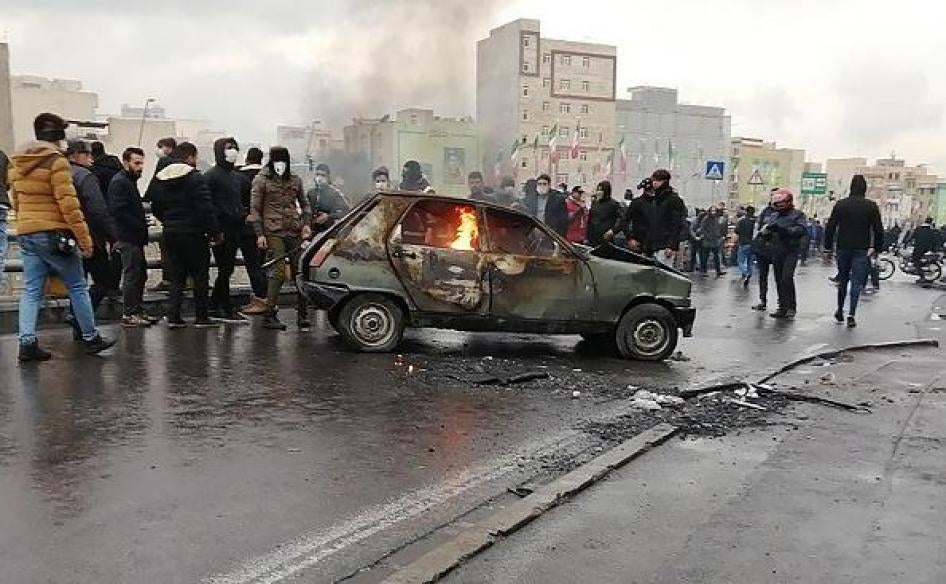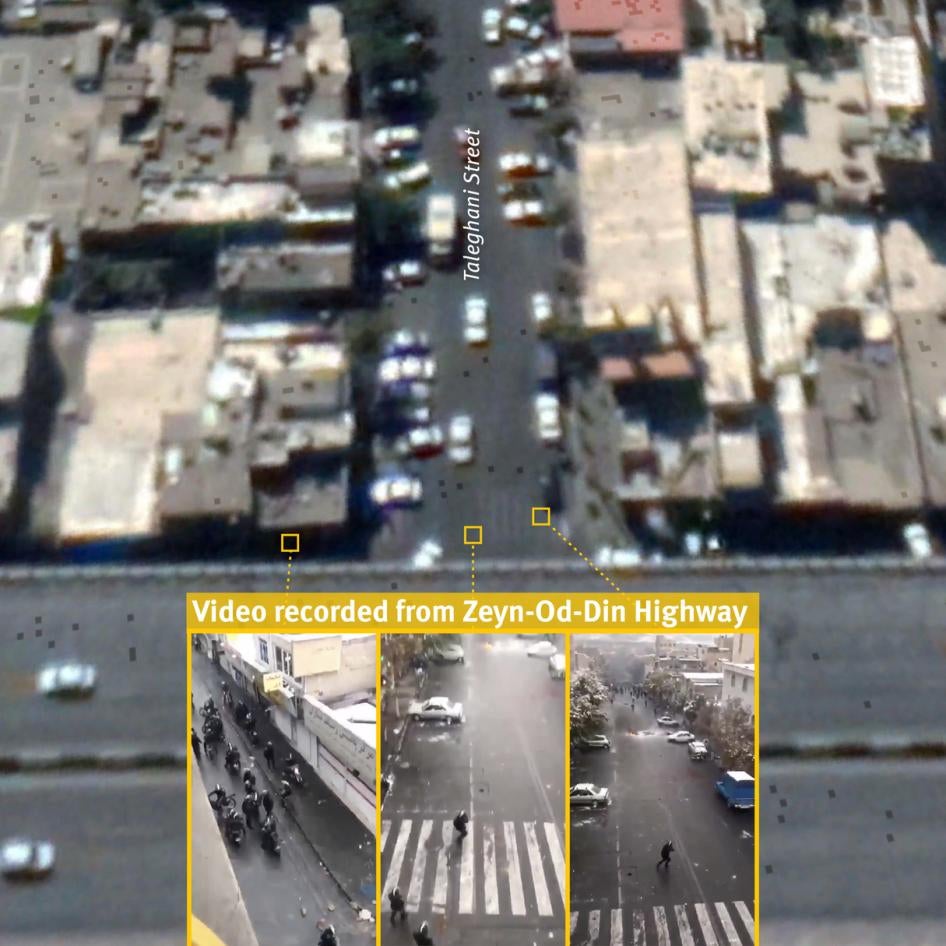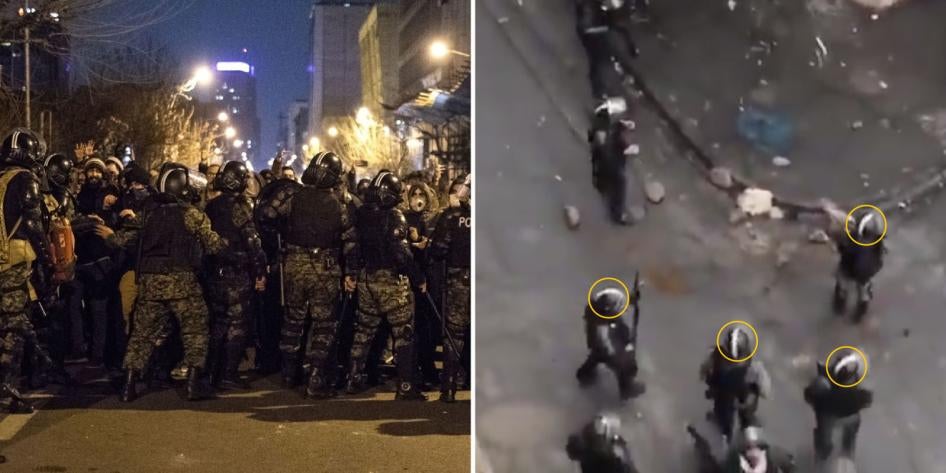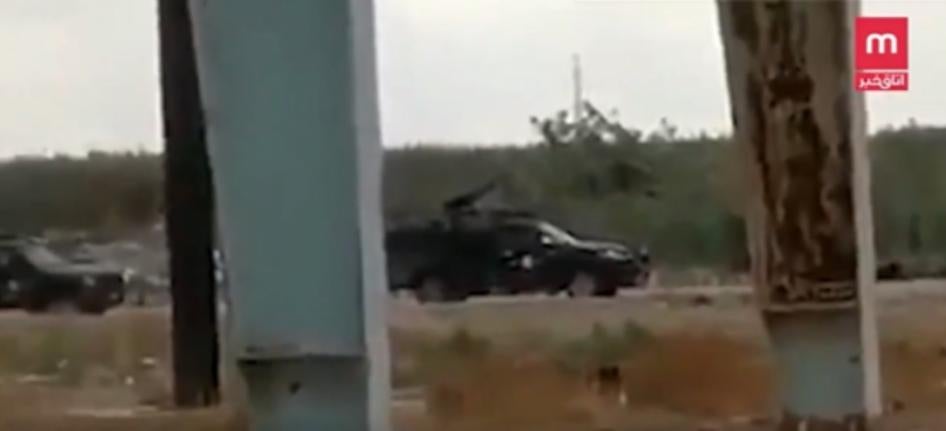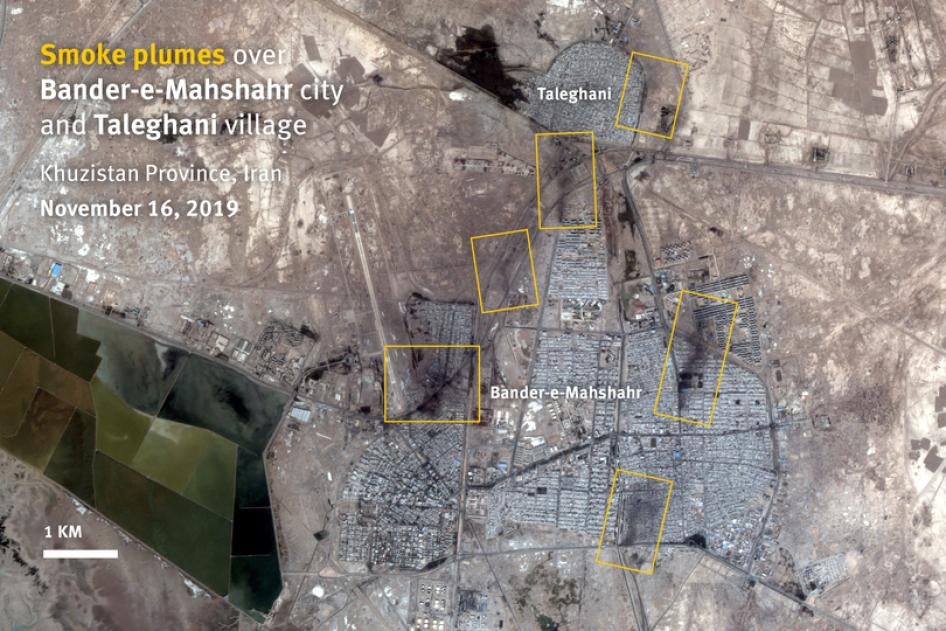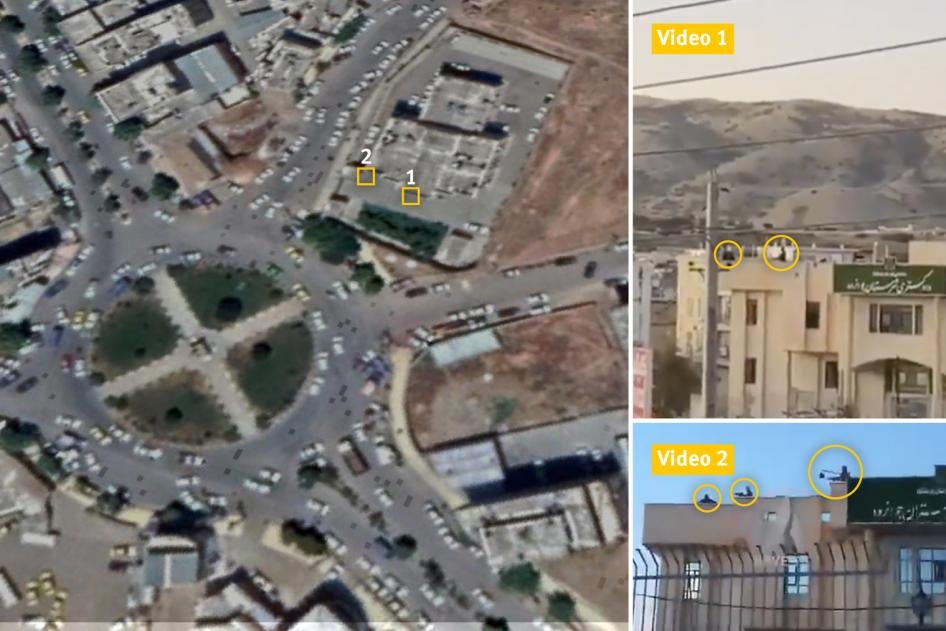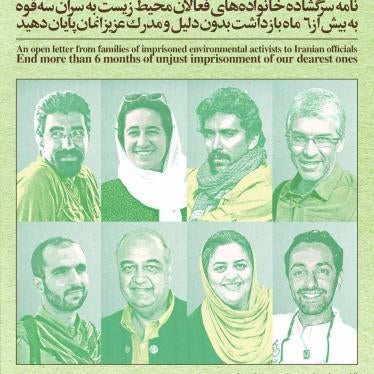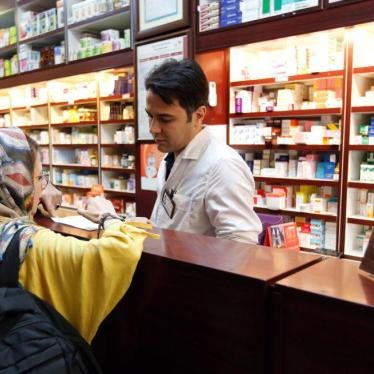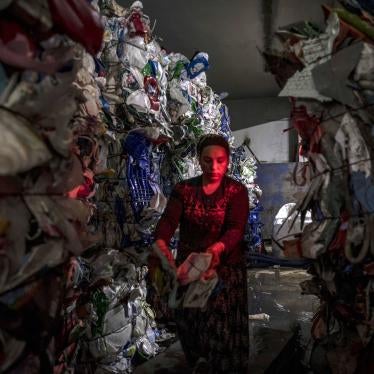(Beirut) – Iranian authorities have failed to hold security forces accountable for excessive and unlawful use of lethal force in confronting large-scale protests that began on November 15, 2019, Human Rights Watch said today. Members of the United Nations Human Rights Council should take urgent action to address the brutal crackdown.
Over three months later, the government has failed to announce the total number of deaths and arrests during the protests, which spread to many parts of the country over a week. Interviews with victims and witnesses, a review of photos and videos from the protests, and satellite imagery analysis strongly suggest that security forces used unlawful lethal force on at least three occasions. The total number of such cases is most likely higher.
“Iranian authorities have systematically repressed dissent for decades, and they are now confronting popular protests with an astonishing level of violence,” said Michael Page, deputy Middle East director at Human Rights Watch. "Principled international voices should send an unequivocal message that Iran cannot get away with killing protesters.”
The protests began over an abrupt fuel price increase, but they transformed into broader popular discontent with the government’s repression and perceived corruption. The government imposed a near-total internet shutdown from November 15 to 19.
Due to the internet shutdown and authorities’ threats against families of victims, documenting the full extent of the crackdown, including the total number of people killed, has been difficult. Amnesty International has estimated that at least 304 people were killed. The Human Rights Activists News Agency (HRANA) has verified the identities of more 100 people killed. Media reports indicate that the death toll may be much higher. A member of parliament put the number at 170, while official media outlets have reported the deaths at least 5 members of the security forces during the protests. One parliament member said about 7,000 people were arrested.
Four informed sources told Human Rights Watch that the authorities have banned families from conducting interviews with media and threatened them with retaliation if they do. On December 23, the authorities arrested several members of the Bakhtiari family after they called for a public mourning to commemorate the 40th day of their son’s death. On January 22, the authorities released Bakhtiari’s father, pending trial.
After initially greenlighting the crackdown, Supreme Leader Ayatollah Ali Khamenei was later quoted as saying that families of people killed who had not been protesting should be compensated, and that detained protesters should be treated with what he called “Islamic mercy.” However, nothing in Khamenei’s response to the events suggests that the security forces will be investigated for their excessive and unlawful use of force. Moreover, according to several media outlets, prison authorities have beaten and abused detained protesters. There are also reports of Iran’s revolutionary courts sentencing at least 3 arrested protesters to death.
Human Rights Watch interviewed nine people, including witnesses, victims’ family members, and others with firsthand knowledge of the security forces’ violent response to protests in Khuzestan, Fars, Kermanshah and Alborz provinces. Human Rights Watch also reviewed videos and photos of incidents in which security forces apparently used unlawful and excessive lethal force, as well as satellite imagery of some protest locations. The evidence strongly suggests that on at least three occasions, security forces used unlawful lethal force while responding to protesters who were blocking roads, or in some cases throwing stones and attempting to take over public buildings.
Photos and videos of the protests circulating on social media and verified by Human Rights Watch indicate that the Special Forces under the supervision of Iran’s Islamic Revolutionary Guard Corps (IRGC), as well as the Special Forces belonging to the Law Enforcement Force of the Islamic Republic of Iran (NAJA), played major roles in the government’s violent crackdown.
People interviewed and videos on social media indicate that in at least three instances security forces shot people who were fleeing the scene of protests. One of these cases can be seen in a video posted online on November 17, 2019, recorded from Zeyn-Od-Din Highway overlooking Taleghani Street in Tehran. The video shows people on Taleghani Street starting a fire, while others throw what appear to be sticks and stones at security forces. About two dozen security force personnel are visible, dressed in black with a white stripe on their helmets. One of them opens fire at people on the street but it is unclear if anyone got hit.
The black uniforms and black helmets with white stripes are worn both by forces of the IRGC, as well as by the Basij, a paramilitary force under the IRGC with responsibilities for internal security and a long track record of committing serious human rights violations.
A person with close knowledge of a second case said that Borhan Mansournia, a 28-year-old veterinarian, told his family that on November 16, security forces shot him in Dolatabad, in Kermanshah province, while he was running away from security forces who were shooting at protesters.
Mansournia told his family while he was injured in the hospital that two other protesters were killed there. Mansournia was hospitalized with gunshot injuries and died on November 18. The authorities have refused to provide Mansournia’s family with information about the weapon and ammunition that killed him and threatened Mansournia’s family with arrest if they speak with the media.
Family members and people with close knowledge of four other cases of people killed said that in each case the victim died from gunshots to the head and/or chest. A family member of Pouya Bakhtiari, a 27-year-old electrical engineer, said that security forces fatally shot Bakhtiari in the head during a November 17 protest in Karaj, in Alborz province. A relative of a 15-year-old child, Mohammad Dastankhah, said that security forces shot him in the heart on November 16 as he was returning from school in the town of Sadra, the city of Shiraz, in Fars province.
Nearby and on the same day, Alireza Anjavi, a 27-year-old graduate of architecture studies, told his mother by phone that he was passing through a protest area. His family heard nothing more from him. A week later, a security agent called Anjavi’s mother to inform her that her son had been shot dead. Anjavi was shot in the forehead, a source with close knowledge of the case said.
The area surrounding Bander-e-Mahshahr, a city in Khuzestan province, experienced some of the most violent repression. Two local residents said that on November 18, special units opened fire on protesters who had been blocking roads in the town of Chamran since November 16, as well as on those who were fleeing to a marsh close by. The security forces appeared to use live ammunition and heavy machine guns, the two residents said. Videos posted to social media show tanks being deployed in Taleghani town and a pickup truck equipped with an automatic weapon in Chamran. At least one member of the security forces was reportedly shot and killed during the clashes on November 18 in the Chamran area, and another law enforcement officer there died of his injuries a week later.
The video showing a vehicle with an automatic weapon in Chamran appeared online on December 3, 2019. The exact location of where the video was recorded was identified by France 24 as part of a detailed investigation it conducted into the protests and crackdown.
HRANA reported that people wounded during protests in Karaj, Islamshahr, Bahbahan, and Sirjan avoided seeking treatment in hospitals for fear of being arrested. At least two people injured during these protests died from their wounds, HRANA reported.
Prisoners detained in Rajai Shahr and Evin prisons have reported that prison authorities beat arrested protesters. The Center for Human Rights in Iran reported that lawyers still have not been able to get information about the condition of people arrested as “leaders” of the protests.
“Iran should not use geopolitical turmoil to distract from holding perpetrators accountable,” Page added. “The families of those killed deserve a thorough and transparent investigation instead of authorities trying to threaten and coerce the families into silence.”
Lethal Force Against Protesters
According to the HRANA, protests took place in more than 104 cities. It appears that the majority of reported casualties and damage to public properties occurred between November 15 and November 19. Human Rights Watch investigated incidents of protesters’ deaths and security forces’ excessive use of force in three provinces.
Khuzistan Province
Some of the worst violence took place in Khuzistan Province, where authorities responded to roadblocks set up by protesters in Bander-e-Mahshahr and nearby towns with heavy weapons and lethal force. The area is close to Iran’s major petrochemical facility and its Petrochemical Special Economic Zone (PETZONE). It is also home to Iran’s Arab minority.
Two residents who spoke with Human Rights Watch emphasized that the economic marginalization of people who live in small towns near one of the main sources of Iran’s national revenue has contributed to resentment against the authorities. Over the past few years, local authorities and journalists have reported problems in accessing clean drinking water in the area. Authorities have also reported waste management and health issues, including petrochemical waste that has contributed to water pollution in the area. In the past, various separatist groups have also been active in the area and have claimed responsibility for violent acts.
The two residents, who witnessed the events, said that protests in the town of Chamran started on November 15, when the authorities announced the abrupt fuel price increase. One resident said:
On Friday evening, when I tried to get gas at the station, protesters who had blocked the gas station close to the entrance of the town asked me not to use the gas station and to support them in their strike but they didn’t use any violence. When I tried to go to work on Saturday morning the roads were already closed.
By the morning of November 16, protesters had blocked Besat Square, which connects Chamran to Bander-e-Mahshahr and the special economic zone where the petrochemical facilities are located, preventing cars from leaving or entering the town. One of the local residents said
The protesters who had blocked the road did not have guns. They had used tires and had also bent two electricity poles to block the road. They weren’t allowing the cars to pass but my relatives were able to get back to the town through rural roads after negotiating with people who had closed it.”
Both local residents said that protesters covered their faces, but they appeared to be local youth. One of the residents said:
You could hardly find anyone above the age 30 among them. They were kids from the area. Local authorities tried to open the road for two days but had not succeeded. But I’m not aware of any clashes or shooting that took place during those two days. Some of the staff who had left early Saturday morning ended up staying at work for a few nights.”
On the morning of November 18, forces dressed in anti-riot special forces uniforms arrived with armed vehicles, apparently to open the closed road. The two local residents said the forces belonged to the IRGC.
One of the residents said that at around 9:30 a.m. local time on November 18, someone hiding in the marsh alongside the road between the entrance of Chamran and Besat Square shot at special forces deployed in the area. Security forces responded by opening fire with Dushka (DShK) machine guns at the protesters. Some protesters subsequently sought shelter in the marsh. The security forces then set fire to the entrance of the marsh area to make sure no one was hiding there, one of the residents said.
One of local residents said that at least 20 people were killed in the marsh, with 8 confirmed dead at the hospital. A security officer was among the wounded who was transferred to a nearby hospital and later died.
The Tasnim news agency, which is close to Iran’s Revolutionary Guards, quoted a witness who said that Reza Sayadi, a commander of the Iranian Counter Terrorism Police Forces (NOPO), was shot in the head during clashes around the marsh. An IRGC member, Akbar Moradi, was shot in the chest and abdominal area and died later, reported Fars News, an outlet close to the IRGC.
Later in the afternoon, authorities raided houses in the area and rounded up dozens more people, both residents said. Families do not know where their loved ones are detained, and the authorities have pressured the families not to speak to the media or hold public ceremonies.
The authorities have admitted that security forces opened fire on people but said that the protesters were armed. On December 3, Mohsen Biranvand, the governor of Mahshahr, told Fars News Agency that “When armed separatists came to the area, security forces stood in front of them with force to teach them a lesson.”
On December 12, Mahmoud Vaezi, the head of President Rouhani’s office, told reporters that “Armed individuals were shooting at shooting at the police and the people.” On the same day, Amirhossein Ghazizadeh Hashemi, a parliament member from Mashhad, told students in a speech that “a high number of people have been killed in Mahshahr, but when they wanted to harm the major energy routes in the country, how would those responsible for security of those routes respond?”
Human Rights Watch reviewed satellite images from November 19 and 21 that show debris and dark stains on the roads, especially on roundabouts, including Besat Square and intersections in the towns of Chamran and Bandar-e Mahshahr. An image from November 19 also shows a likely burn scar in the marsh south of Chamran, next to the main road, that is consistent with the reported burning of the marsh. The cause of the dark stains remains unclear.
Ahwaz Human Rights Organization has published the names of 16 people probably killed during the marsh shootings on November 18. HRANA confirmed the identity of at least three people killed in the marsh. The Ahwaz Human Rights Organization also reported that at least three security officers were injured in the clashes, and one was killed.
The Ahwaz Human Rights Group said that after the clashes broke out, three local people responded to security forces’ “indiscriminate firing” with shooting. The two local residents of Chamran that Human Rights Watch interviewed said that after security forces cleared area roads with lethal force in the afternoon, they heard security forces moving to the town of Taleghani (also known as Koureh-ha) town, 20 kilometers from Chamran. A video posted to social media shows a tank blocking the entrance of Taleghani.
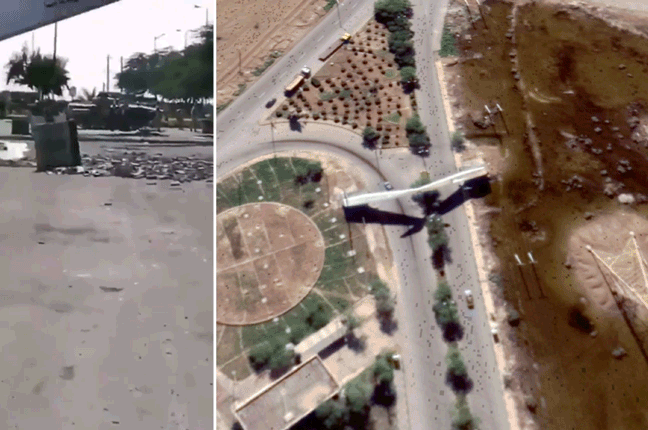
The Ahwaz Human Rights Organization has published the names of three people allegedly killed during the shootings that took place in that area.
Satellite imagery recorded on the morning of November 16 shows at least eight distinct smoke plumes along streets in Bandar-e Mahshahr and Taleghani, consistent with the protesters burning tires or other materials.
Kermanshah Province
Security forces apparently shot Borhan Mansournia, a 28-year-old veterinarian, while he was fleeing attacks on protesters on the evening of November 16 in the town of Dolatabad in Kermanshah province. Mansournia died in Taleghani hospital in Kermanshah 34 hours later.
A source with direct knowledge of his death said that at around 5:30 p.m. on November 16, Mansournia told a family member in a phone call that protesters were climbing up the walls of police station number 25 in Dolatabad area. While people had assumed that the guards had left their posts, the police opened fire toward the first row of people climbing up the wall.
Mansournia was standing in the last row, the source said. When the police started shooting, he and other protesters fled in the opposite direction, but the special forces of Kermanshah had apparently gathered behind the protesters with anti-riot vehicles. When Mansournia realized that he was running toward them, he apparently turned around and began running back toward the police station when security forces shot him and two others, who reportedly died in the street. The bullet hit Mansournia above the waist close to his spine, leaving a hole three times as big as a pencil tip, and leaving two large holes in his abdomen, the source said.
An ambulance took Mansournia to Farabi Hospital, the closest one, but hospital authorities refused to accept him, saying they did not have specialized equipment to treat such an injury, source said. After about 90 minutes, Mansournia was transferred to Taleghani Hospital, which specializes in traumatic injuries.
The hospital first refused to take him, saying it lacked capacity, but ultimately agreed, the source said. On the early morning of November 17, Mansournia underwent 4 to 5 hours of surgery, after which he had to stay in a bed in a hallway for 8 hours due to lack of space and was then was taken to the hospital general ward. He died there on November 18, the source said.
On the night of November 16, at least eight people died of gunshot wounds in Taleghani Hospital, the source said.
The authorities performed an autopsy on Mansournia and had weapons experts prepare a report on the bullet, but they have refused to provide the family with any information, the source said. The prosecutor in Kermanshah has only allowed the family to see part of the medical report, which said that Mansournia suffered from serious injuries to his kidneys, intestines, and liver. The authorities coerced the family to sign a pledge not to talk to the media and have been told not to hope for an investigation.
A person who observed the protests told Human Rights Watch that people had gathered close to Azadi Square in the city of Kermanshah to protest the fuel price increase, clapping and chanting slogans against the rising prices on the morning of November 16, when a fire department truck sprayed water toward them without warning. Within minutes, clashes broke out, the person said, with police special forces shooting tear gas and bullets, and people setting fires. “Within half an hour I thought I was in the middle of hell,” the witness said. “Later, with friends I went to other areas of town. The area was too tense to get out of the car, but we could see clashes in Dolatabad and Jafarabad towns.”
On November 18, 2019, in Javanrud, 90 kilometers from Kermanshah, security forces appear to have shot down at a square where protesters had gathered from the roof of the courthouse.
Two videos posted to Twitter, viewable here and here, both appear to show three members of the security forces on the roof firing single shots from assault rifles onto the square where people had gathered. It remains unclear whether anyone was wounded or killed.
Fars Province
Human Rights Watch documented three deaths in Shiraz, in Fars province, and surrounding areas on November 16. Multiple videos circulated on social media show protests in Maliabad and Aledbad neighborhoods in Shiraz, as well as Sadra, a small town 40 kilometers north of Shiraz.
Dina Jafari told Human Rights Watch that her cousin, Bahman (Reza) Jafari, 28, left home in the Fargaz (Fatholmobin) neighborhood to go to work at about 8:30 a.m. on November 16 and was shot close to the Adel Abad (prison) intersection. At about 11:30 a.m., the family received a call from a person who did not identify themselves saying that Jafari had “an accident” and had been transferred to a local clinic, another source said.
When the family arrived at the clinic, they saw he had been shot. Medical staff told the family that they did not have the necessary equipment to treat Jafari, and that he needed to be transferred to Shiraz hospital immediately. Jafari died on the way to the hospital, two sources confirmed. His body was immediately transferred to the medical examiner’s office and the family was not allowed to see it, the source said.
Jafari was shot four times, including below his heart and under his arm, his cousin Dina said. She said that a doctor at the medical examiner’s office told his family that Jafari was shot at close range.
On November 25, the governor’s office in Shiraz asked Jafari’s father to sign a pledge not to speak with foreign media and to hold a “quiet” memorial service for his son. He agreed in order to get the papers required to remove his son’s body from the medical examiner’s office. The authorities did not allow the family to bury Jafari in the Darorahmeh cemetery in Shiraz, as the family wanted, but instead compelled them to bury him in a cemetery 40 kilometers from the city. The authorities also prevented the family from performing their traditional memorial rituals at their home. The family has filed a complaint. The authorities promised to follow up but have not gotten back to the family.
The governor’s office told the family that their son’s case is “open” and the authorities will determine if the family has to pay for the grave, one of sources said. The authorities have raised the possibility of calling Jafari a martyr and assisting the family financially, both of which the family rejected, insisting that they wanted to identify the person responsible for their son’s death. The authorities told the family that the investigation “will take a long time,” the same source said.
Human Rights Watch also spoke to two families whose loved ones were killed by gunshots during protests in the town of Sadra on November 16. The town was the scene of protests that day. The Friday prayer Imam of Sadra told Mashregh News on November 19 that during the protests “rioters” set his office, the mosque, and the adjacent registration office on fire.
Mohammad Dastankhah, a 15-year-old student who was wearing his school uniform, was shot dead with a bullet to his heart on Moulana Boulevard close to the mosque, his father said. When Dastankhah’s mother realized that his school had closed early, around 2:20 p.m., and he had not come home by 4:30 p.m., she went looking for him, Dastankhah’s father told Human Rights Watch.
The family decided to check the hospitals because people in the area told them that there had been shootings earlier. When Dastankhah’s mother arrived at Sadra hospital around 9:30 p.m., the staff informed her that her son’s body was there, and he had been dead on arrival.
Dastankhah’s father said:
Authorities finally allowed us to bury the body on November 20, and the medical report says a bullet in the heart is the cause of death. They have said they’re investigating what happened to Mohammad, but no one has since called or visited our family. The only thing we know is that our son was on his way back from the school. We don’t know how he was shot. We have filed a complaint to investigate his death and another complaint against school officials who didn’t properly communicate the school closure to parents and now claim Mohammad wasn’t in school on that day.”
Dastankhah’s sister told Radio Zamaneh on December 7 that there were seven other dead bodies in the hospital morgue of people who were shot during the protests.
A source with close knowledge of the case told Human Rights Watch that on November 16, Alireza Anjavi, a 27-year-old architecture graduate, told his mother by phone that he was passing through the protests in the same area. When he did not come home that evening, his mother asked her brother-in-law who knew people in the police forces to help locate her son, the source added. He told her that according to his sources Anjavi had been detained.
A week later, the authorities from police station number 8 in Golkooh neighborhood in Shiraz called Anjavi’s mother and asked her for information about his clothing, work, and ID, and ultimately told her to go to the medical examiner’s office in Shiraz. The authorities called her again in the evening to ask her why she had not visited the office yet. According to the source, Anjavi’s mother provided her brother-in-law’s contact information to the authorities. Authorities showed him a photo of Anjavi and said he was dead. On November 25, the authorities called Anjavi’s family to retrieve his body and told them that they needed to bury him on the same day in one of the three cemeteries they had allocated for burial. There was a gunshot wound in Anjavi’s forehead, the source said.
A video circulated on IranWire, a news website, and verified by France 24, shows armed men shooting toward protesters from a base belonging to the Basij paramilitary forces in the area. France 24 identified the base as Shahid Tavana, which is in the vicinity where Dastankhah and Anjavi were shot dead.
A video circulated on IranWire, a news website, and verified by France 24, shows armed men shooting toward protesters from a base belonging to the Basij paramilitary forces in the area. France 24 identified the base as Shahid Tavana, which is in the vicinity where Dastankhah and Anjavi were shot dead.
Government and Lawmakers’ Statements
Several government officials have attempted to justify the security forces’ unlawful use of force by calling the protesters “rioters.” On November 18, Keyhan newspaper, which is close to the country’s security apparatus and Ayatollah Khamenei’s office, wrote that “there are reports that suggest judicial authorities are considering execution by hanging as the destiny for the rioters.”
President Hassan Rouhani, who promised during the 2016 re-election that people would enjoy greater human rights freedoms as part of his second term, also used the term “rioters.” On November 23, Rouhani said during a cabinet meeting that “a few of [the protesters] were rioters but they were organized, had plans and were armed and were directed by backward forces in the region, Zionists, and the US.” On December 4, Ayatollah Khamenei endorsed recommendations by the secretary of the National Security Council to consider ordinary citizens who died during the protests but did not participate in them “martyrs,” and to provide government support to their families. He also recommended treating those suspected of “villainy,” along with their families, with “Islamic mercy.”
On December 5, Etemad newspaper reported that President Rouhani had ordered the formation of a committee to “investigate the situation of people who were harmed during recent events and separate those who did not intend to riot from those creating terror and fear.”
Hossein Naghavi Hosseini, a parliament member, said that authorities arrested about 7,000 people during the protests. He also told media that an Intelligence Ministry representative told the parliamentary national security committee that most of those arrested were unemployed or held low-paying jobs and had lower levels of education. Prisoners detained in Rajai Shahr and Evin prisons have reported that prison authorities have beaten the arrested protesters.
On December 17, Mahmoud Sadeghi, a parliament member from Tehran, told Etemad that during a parliamentary briefing, a Karaj parliament member said that two people from his district were shot in the head and asked Interior Minister Rahmani Fazli why security forces did not attempt to just target “the lower part of the body.” He said Fazli did not deny that security forces shot protesters in the head, but instead responded that security forces “also targeted people in their feet as well.”
On January 2, Mosfata Kavakebian, a member of the parliamentary National Security Commission, said at a political party conference that “the commission was told that the total number of deaths [during the protests] is 170.”
Four sources told Human Rights Watch that authorities have banned families from conducting interviews with media and threatened them with retaliation. On December 23, authorities arrested several members of the Bakhtiari family after they called for a public mourning to commemorate the 40th day of their son’s death. On January 22, authorities ultimately released Bakhtiari’s father temporarily, pending trial. On January 22, Radio Zamaneh reported that authorities in Kermanshah were pressuring Mansournia’s family to accept their offer to designate Mansournia as a martyr and participate in a state media interview about it.
According to HRANA, people wounded during protests in Karaj, Islamshahr, Bahbahan, and Sirjan avoided seeking treatment in hospitals for fear of being arrested. At least two individuals injured during these protests died from their wounds, HRANA reported.
Legal Standards
Under international human rights law, everyone has the right to freedom of expression and peaceful assembly as provided under the International Covenant on Civil and Political Rights (ICCPR), to which Iran is a party.
Under the UN Basic Principles on the Use of Force and Firearms by Law Enforcement Officials, law enforcement officers may use force only when strictly necessary and to the extent required to achieve a legitimate policing objective. When using force, law enforcement officers should minimize damage and injury and respect and preserve human life. The deliberate use of lethal force is permissible only when it is strictly necessary to protect life.
The authorities are obliged to inform all families of the location of their detained relatives and ensure that detainees are informed promptly of any charges against them and have prompt access to legal counsel and family members. Enforced disappearances occur when the authorities detain someone and deny the detention or fail to provide information on their circumstances or whereabouts.
Under article 4 of Iran’s law on the use of weapons by officers of the armed forces, in urgent cases law enforcement officers may use their weapons upon the order of the commander of the operations to restore order and control illegal demonstrations, and to quell riots, revolts, and commotions that cannot be controlled without the use of weapons under the following conditions:
- Other equipment has been used pursuant to regulations to no effect
- Prior to using weapons, a warning and ultimatum has been given to the rioters and agitators regarding the use of weapons
Iran’s National Security Council ordered the shutdown of access to the global internet when protests broke out across the country. The authorities maintained a near-total internet shutdown for five days, after which they started connecting home internet in areas that did not experience widespread protests. They restored access to internet on mobile phones after 10 days.
Internet shutdowns violate multiple rights, including the rights to freedom of expression and access to information and the rights to peaceful assembly and association. Under international human rights law, Iran has an obligation to ensure that internet-based restrictions are provided by law and are a necessary and proportionate response to a specific security concern. Officials should not use broad, indiscriminate shutdowns to curtail the flow of information nor to harm citizens’ ability to freely assemble and express political views.
